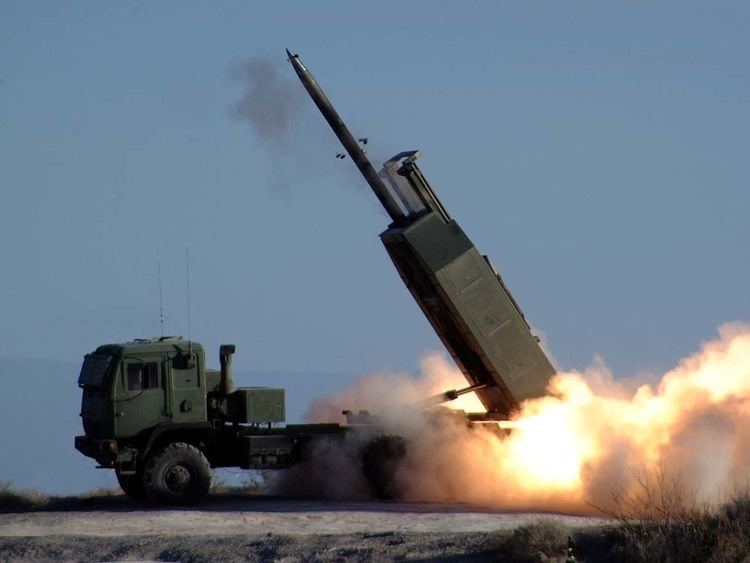Place of origin United States Weight 24,000 lb (10,900 kg) | Unit cost $5.1 million (2014) Length 7 m (23 ft 0 in) | |
 | ||
Type Rocket artillery, Tactical ballistic Manufacturer Lockheed Martin Missiles & Fire Control
BAE Systems (Chassis) | ||
The M142 High Mobility Artillery Rocket System (HIMARS) is a U.S. light multiple rocket launcher mounted on a standard Army Medium Tactical Vehicle (MTV) truck frame.
Contents
- Deployment
- Singapore
- Operational history
- Related developments
- Current operators
- Potential and future operators
- References
The HIMARS carries six rockets or one MGM-140 ATACMS missile on the U.S. Army's new Family of Medium Tactical Vehicles (FMTV) five-ton truck, and can launch the entire Multiple Launch Rocket System Family of Munitions (MFOM). HIMARS is interchangeable with the MLRS M270A1, carrying half the rocket load.
The launcher is C-130 transportable. The chassis is produced by BAE Systems Mobility & Protection Systems (formerly Armor Holdings Aerospace and Defense Group Tactical Vehicle Systems Division), the OEM of the FMTV. The rocket launching system is produced by Lockheed Martin Missiles & Fire Control.
Deployment
The M142 High Mobility Artillery Rocket System (HIMARS) is the light, wheeled version of the M270 Multiple Launch Rocket System (MLRS). The HIMARS utilizes the same pod as the M270 MLRS uses. A pod can hold six rockets or a single missile. The windows are made of glass and layers of sapphire.
18th Field Artillery Brigade (Airborne) at Fort Bragg, North Carolina was the initial army test bed unit for the M142 HIMARS. C Battery, 3rd Battalion, 27th Field Artillery Regiment began field testing 3 HIMARS prototypes in all types of training events and environments in 1998 as a residual of the Rapid Force Projection Initiative (RFPI) Advanced Concept Technology Demonstration (ACTD). In 2002, the United States Marine Corps arranged with the United States Army to acquire 40 of the systems. Fielding began in 2005. In July 2007, Marines from Fox Battery 2nd Battalion 14 Marine Regiment from Oklahoma City, Oklahoma were deployed to the Al Anbar province of Iraq. This is the first Marine unit to use the HIMARS in combat.
HIMARS was also tested as a common launcher for both artillery rockets and the surface-launched variant of the AMRAAM anti-aircraft missile.
Singapore
As of September 2007, the Singapore Army proposed to acquire HIMARS systems. The package includes 18 HIMARS launchers, 9 FMTV 5-Ton Trucks and XM31 unitary HE GMLRS pods, plus associated support and communications equipment and services. This proposed package is notable for not involving the M-26 unguided MLRS rockets. In late 2009, Singapore took delivery of the first HIMARS firing unit and achieved Full Operational Capability. The 23rd Battalion, Singapore artillery commissioned its HIMARS battery on 5 September 2011. It marks the first fully GPS-guided HIMARS unit.
Operational history
On February 14, 2010, the International Security Assistance Force (ISAF) for Afghanistan indicated in a press release that it was thought that two rockets fired from a HIMARS unit fell 300 metres short of their intended target and killed 12 civilians during Operation Moshtarak. ISAF suspended the use of the HIMARS until a full review of the incident was completed. A British officer later said that the rockets were on target, that the target was in use by the Taliban, and use of the system has been reinstated. Reports indicate that the civilian deaths were due to the Taliban's use of an occupied dwelling, the presence of civilians at that location was not known to the ISAF forces. An October 21, 2010 report in the New York Times credited HIMARS with aiding the NATO offensive in Kandahar by targeting Taliban commanders' hideouts, forcing many to flee to Pakistan, at least temporarily.
In November 2015, the United States Army revealed they had deployed the HIMARS to Iraq, firing at least 400 rockets at the Islamic State since the beginning of summer. HIMARS detachments were sent to Al Asad Airbase and Al-Taqaddum Air Base in Anbar province. On 4 March 2016, Army HIMARS systems fired rockets into Syria in support of Syrian rebels fighting ISIL for the first time, with the launchers based in neighboring Jordan.
In January 2016, Lockheed announced the HIMARS had reached 1 million operational hours with U.S. forces, achieving a 99 percent operational readiness rate.
On April 26, 2016, it was announced that the U.S. would be deploying the HIMARS in Turkey near the border with Syria as part of the battle with ISIL. In early September, international media and the U.S. State Department reported a newly-deployed HIMARS systems had engaged ISIL targets in Syria near the Turkish border.
In October 2016, HIMARS systems were stationed at Qayyarah Airfield West, some 65 kilometers south of Mosul, taking part in the Battle of Mosul.
Related developments
Lockheed Martin UK and INSYS had jointly developed a demonstrator rocket artillery system similar to HIMARS for the British Army's 'Lightweight Mobile Artillery Weapon System/Rocket' (LIMAWS(R)) program. The system consisted of a single MLRS pod, mounted on a Supacat SPV600 chassis. The LIMAWS(R) programs was cancelled in September 2007.
Current operators
Singapore
United Arab Emirates
Jordan
Potential and future operators
The Department of National Defence considered the purchase of HIMARS. The former Chief of the Land Staff, Lieutenant-General Andrew Leslie, said the plan to acquire rocket launchers was something that "would be considered much further down the road—possibly in the 2012 time frame.
In December 2012, Qatar notified the U.S. of a possible Foreign Military Sale of 7 M142 HIMARS systems, as well as 60 M57 MGM-140 ATACMS Block 1A T2K unitary rockets and 30 M31A1 Guided Multiple Launch Rocket System (GMLRS) unitary rockets. The deal would cost an estimated $406 million.
New Multiple Launch Rocket System. Program "Homar" Poland. Multiple Launch Rocket System Cooperation between Huta Stalowa Wola, ZM Mesko and Lockheed Martin.
Future substitute of the Teruel MRL.
